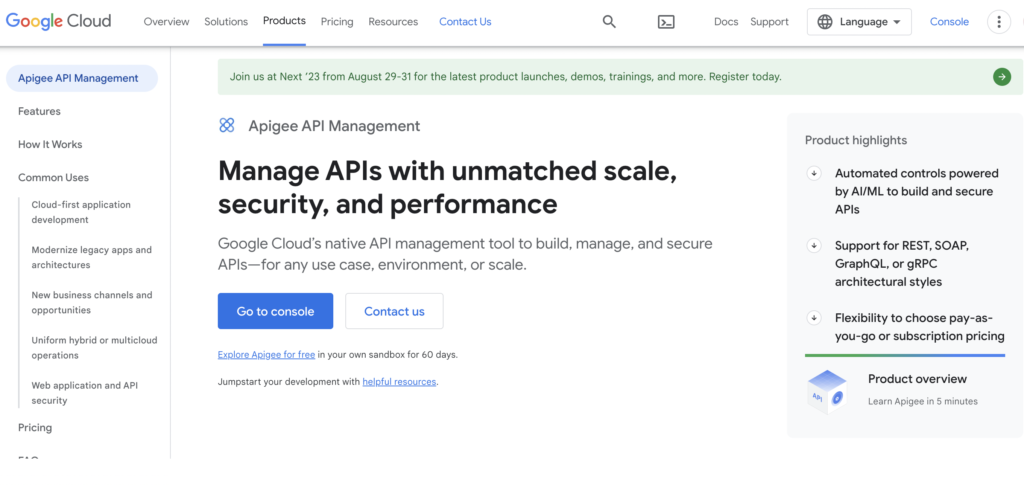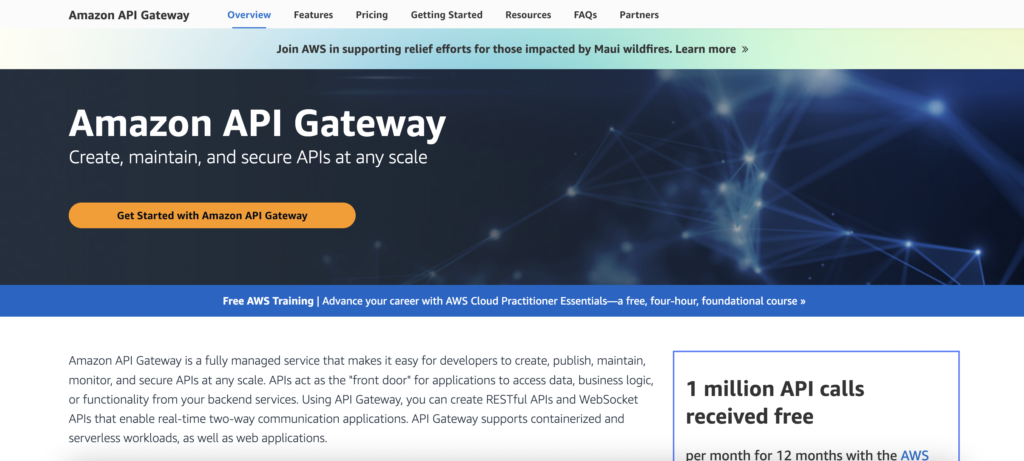Apigee API Management and Amazon API Gateway are two of the most popular API management solutions available today. Both services provide essential features for distributing APIs, but their approaches differ significantly from each other. In this document, we will compare Apigee and Amazon API Gateway in detail, covering factors such as functionality, flexibility, ease of use, and performance.
By the end of this document, you will have a better understanding of the differences between these two services and be able to make an informed decision on which one is best suited for your specific use case.
Apigee: Features, Benefits, and Use Cases
Overview of Apigee API management platform:
Apigee API Management is a cloud-based platform that provides end-to-end API management capabilities. It allows developers to create, publish, secure, and analyze APIs at scale. The platform offers a range of features and functionalities, including API creation and design tools, analytics and monitoring, security and authentication options, and a developer portal and documentation. Apigee API Management is highly scalable and can handle millions of API requests per day.

Key features and functionalities:
Apigee API Management offers a range of features and functionalities that make it easy for developers to manage APIs. The API creation and design tools allow developers to create and manage APIs using a range of protocols and formats. The analytics and monitoring features provide real-time insights into API performance and usage. The security and authentication options include OAuth 2.0 support, Cloud Armor, and CMEK. The developer portal and documentation provide a solid starting point for managing API documentation, community forums, and other resources for developers.
Benefits of using Apigee:
There are several benefits of using Apigee API Management, including the ability to create, publish, secure, and analyze APIs at scale. The platform offers a range of features and functionalities that make it easy for developers to manage APIs, including API creation and design tools, analytics and monitoring, security and authentication options, and a developer portal and documentation. Additionally, Apigee API Management is highly scalable and can handle millions of API requests per day. It also offers flexible pricing plans to meet the needs of organizations of all sizes.
Use cases showcasing successful implementations:
Apigee API Management has been successfully implemented by a range of organizations, including large enterprises and those with scalability and performance requirements. For example, a large financial services company used Apigee API Management to create a unified API platform that enabled them to securely expose their services to external partners and developers. Another use case involved a large retailer that used Apigee API Management to manage their APIs and provide a seamless customer experience across multiple channels. Apigee API Management is also ideal for organizations with scalability and performance requirements, as it can handle millions of API requests per day and offers flexible deployment options.
AWS API Gateway: Features, Benefits, and Use Cases
Overview of AWS API Gateway service:
AWS API Gateway is a fully managed service that makes it easy for developers to create, deploy, and manage APIs at any scale. The service allows developers to create RESTful APIs or WebSocket APIs with real-time updates that enable communication between applications. AWS API Gateway also provides a range of features and functionalities, including API deployment and management, integration with AWS services, security and authorization mechanisms, and caching and performance optimization.

Key features and functionalities:
AWS API Gateway provides a range of features and functionalities that make it easy for developers to manage APIs. The API deployment and management features allow developers to create and manage APIs using a range of protocols and formats. The integration with AWS services allows developers to easily connect their APIs to other AWS services, such as AWS Lambda, Amazon S3, and Amazon DynamoDB. The security and authorization mechanisms include support for OAuth 2.0, AWS Identity and Access Management (IAM), and Amazon Cognito. The caching and performance optimization features allow developers to improve the performance of their APIs by caching responses and reducing the number of requests to backend services.
Benefits of leveraging AWS API Gateway:
There are several benefits of leveraging AWS API Gateway, including the ability to create, deploy, and manage APIs at any scale. The service offers a range of features and functionalities that make it easy for developers to manage APIs, including API deployment and management, integration with AWS services, security and authorization mechanisms, and caching and performance optimization. Additionally, AWS API Gateway is highly scalable and can handle millions of API requests per day. It also offers flexible pricing plans to meet the needs of organizations of all sizes.
Use cases illustrating effective utilization:
AWS API Gateway has been effectively utilized by a range of organizations, including those with serverless architectures and those that integrate with AWS Lambda functions. For example, a large media company used AWS API Gateway to create a serverless architecture that allowed them to easily manage their APIs and scale their infrastructure as needed. Another use case involved a large e-commerce company that used AWS API Gateway to integrate their APIs with AWS Lambda functions, allowing them to easily manage their APIs and reduce the number of requests to backend services. AWS API Gateway is also ideal for organizations that require high scalability and performance, as it can handle millions of API requests per day and offers flexible deployment options.
Comparison: Apigee vs. AWS API Gateway
A. Pricing models and cost considerations:
When comparing Apigee and AWS API Gateway, one crucial aspect to assess is their pricing models and associated cost considerations. Apigee offers tiered pricing plans based on the scale of API usage and specific features required. This allows organizations to choose a plan that aligns with their budget and growth expectations. On the other hand, AWS API Gateway follows a pay-as-you-go model, charging based on the number of API calls and data transferred. Evaluating the projected usage and understanding the potential cost implications of each platform is essential in making an informed decision.
B. Ease of use and learning curve:
Ease of use and the learning curve are pivotal factors influencing the adoption of any technology. Apigee provides a comprehensive set of tools and a user-friendly interface for API design, deployment, and management. Its intuitive developer portal and documentation facilitate efficient onboarding for both developers and administrators. In contrast, AWS API Gateway, while offering powerful capabilities, might present a slightly steeper learning curve due to the intricacies of AWS’s ecosystem. Organizations must consider the technical proficiency of their team and the time required for mastering the platforms.
C. Scalability and performance benchmarks:
Scalability and performance are paramount in modern API management solutions. Apigee boasts a cloud-native architecture designed to handle high API traffic volumes seamlessly. Its auto-scaling capabilities ensure optimal performance during peak usage. AWS API Gateway, backed by Amazon’s vast cloud infrastructure, also offers robust scalability options. Performance benchmarks, such as response times and throughput, need to be compared based on the specific requirements of an organization’s APIs to determine which platform better aligns with scalability needs.
D. Integration capabilities with external systems:
The ability to seamlessly integrate with external systems is a critical consideration for API gateways. Apigee provides extensive integration options, supporting a wide array of back-end systems, databases, and third-party services. Its integration with Google Cloud services further enhances its ecosystem. AWS API Gateway leverages the connectivity of the AWS ecosystem, enabling tight integration with other AWS services. Evaluating the compatibility of each platform with existing systems and preferred technologies is essential for successful integration.
E. Security features and compliance considerations:
Security is paramount in API management, and both Apigee and AWS API Gateway offer comprehensive security features. Apigee provides features like OAuth authentication, API key management, and role-based access control. Additionally, it offers compliance certifications such as SOC 2 and HIPAA. AWS API Gateway integrates with AWS Identity and Access Management (IAM) for authentication and authorization, along with features like custom authorizers and AWS WAF for protection against web attacks. Organizations must assess their specific security requirements and regulatory compliance needs to determine which platform offers the necessary safeguards.
Ending Notes
Ultimately, the choice between Apigee and AWS API Gateway depends on a thorough evaluation of these factors in the context of an organization’s goals, infrastructure, and specific API management requirements.
FAQs
Is Apigee similar to API Gateway?
While the API gateway is a critical component of the API management solution, it is insufficient to manage APIs throughout their lifespan. This is where Apigee comes into play. Apigee’s API management platform’s services enable efficient management of all aspects of an API program.
Can we use Apigee with AWS?
Whether your backend is running on EC2, or using Amazon’s latest compute infrastructure – AWS Lambda – you can take advantage of Apigee’s Cloud (running on AWS) to get best-in-class performance and maintain rock-solid security.
Is AWS API Gateway a load balancer?
An API gateway vs. load balancer comparison can be boiled down to the fact that they both manage traffic entering your website or application but have different roles. An API gateway handles authentication and security policies, while a load balancer API distributes network traffic across multiple servers.
References

















